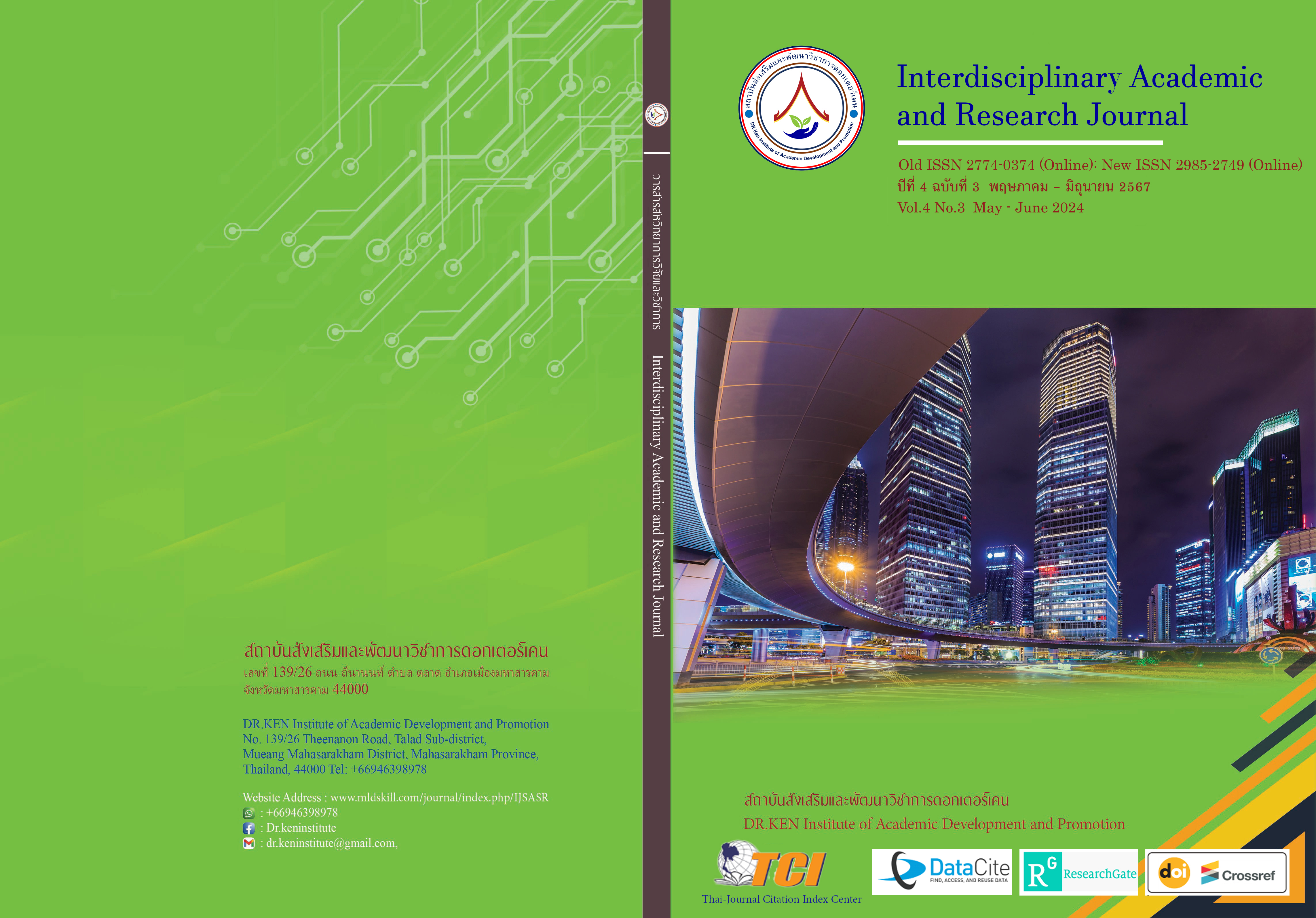Strategies for Creative Tourism Development in Ban Ngio Subdistrict, Sam Khok District, Pathum Thani Province
DOI:
https://doi.org/10.60027/iarj.2024.275815Keywords:
Strategies; , Creative Tourism; , Ban Ngio SubdistrictAbstract
Background and Aims: Ban Ngio Community, Sam Khok District, Pathum Thani Province It is an area with potential for creative tourism as this area has a historical story. It has its own unique culture, traditions, and wisdom. There is just a lack of promotion and development. Therefore, the research team and the community studied strategies for developing creative tourism with the objective of this research 1) to analyze the tourism potential of Ban Ngio Subdistrict, Sam Khok District, Pathum Thani Province 2) to create a strategy for developing creative tourism of Ban Ngio Subdistrict, Sam Khok District, Pathum Thani Province.
Methodology: It is qualitative research. Important information providers include: 1 village headman, 2 assistant village headmen, 1 representative of the local government organization committee, 7 people, and 4 entrepreneurs, totaling 15 people through the focus group process and workshop
Results: The strengths of the community include 1) the community has local scholars in the field of history, 2) local wisdom such as making crispy noodles, making Khao Chae Krayasart, Sabai Mon, and multi-purpose liquid, 3) the community has good traditions. For example, Songkran has a parade of swan tails and centipede flags. During Buddhist Lent, pray in the Raman style and pray in the middle of the house. 4) The community has important historical sites and tourist attractions, including 7 in one sub-district. 5) The community has love and unity. 6) Wisdom is preserved and included in the curriculum for teaching Sabai Mon. Weaknesses of the community include: 1) Lack of knowledge and understanding of community tourism management. 2) Number of community interpreters. There are few 3) Some cultures have disappeared, such as making centipede flag swan tails. Making Sam Khok jars 4) There is no establishment of a learning center within the community. 5) No group formation that has been certified by the government. 6) Some tourist attractions lack cleanliness. 7) There is no plan for tourism development. 8) The community has no budget from outside sources. 9) There are no accommodations for tourists. Opportunities include 1) convenient land transportation 2) local government agencies give importance to it 3) educational institutions give importance to promoting and developing Obstacles include: 1) lack of budget support from the government sector. 2) Lack of adequate tourism publicity from the government. 3) The government sector does not attach importance to the continuous identity of the community. 4) There is garbage along the river that was not created by people in the community. 5) There is no promotion or tourism activity. 6) There are no network partners. However, the strategy for development was; it is Proactive strategies, 4 strategies, Corrective strategies, 8 strategies, Preventive strategies, 1 strategy, Reactive strategies, and 1 strategy.
Conclusion: The results indicate that the town has a rich local legacy, as evidenced by its historical sites, customs, and scholars from the area, but it also faces difficulties like diminishing cultural traditions and a lack of expertise in tourism management. For sustainable development and the maintenance of its distinct identity, a complete strategy that combines preventative, corrective, proactive, and reactive tactics is essential.
References
กรมการท่องเที่ยว.(2561).แผนยุทธศาสตร์พัฒนาการท่องเที่ยว พ.ศ. 2561 – 2564 ของกรมการท่องเที่ยว. กรุงเทพฯ : วีไอพี ก็อปปี้ปริ้น.
กลุ่มวิชาการและมาตรฐานแหล่งท่องเที่ยว กองพัฒนาแหล่งท่องเที่ยว .(2560). คู่มือการบริหารจัดการแหล่งท่องเที่ยวเชิงสร้างสรรค์. กรุงเทพฯ : กรมการท่องเที่ยว กระทรวงการท่องเที่ยวและกีฬา.
เจนจิรา อักษรพิมพ์. (2560). กลยุทธ์การจัดการท่องเที่ยวโดยชุมชนแบบยั่งยืนในจังหวัดนครราชสีมา. วารสารวิจัยและพัฒนา วไลยอลงกรณ์ในพระบรมราชูปถัมภ์. 12(3),141 – 154.
นิธิภัทร บาลศิริ. (2559).การจัดการท่องเที่ยวเชิงวัฒนธรรมแบบมีส่วนร่วมเพื่อการอนุรักษ์และสืบทอดวิถีชีวิต ภูมิปัญญาท้องถิ่นและอัตลักษณ์ชุมชนมอญบางกระดี่เขตบางขุนเทียน กรุงเทพมหานคร. กรุงเทพฯ :มหาวิทยาลัยราชภัฏธนบุรี.
นุชนารถ รัตนสุวงศ์ชัย. (2554). กลยุทธ์การพัฒนาการท่องเที่ยวเชิงวัฒนธรรม. วารสารมนุษยศาสตร์. 18 (1), 31 - 50
รัฐนันท์ พงศ์วิริทธิ์ธร และ ภาคภูมิ ภัควิภาส. (2556). แนวทางการพัฒนาการท่องเที่ยวเชิงวัฒนธรรมชนเผ่าเพื่อความยั่งยืน. วารสารการวิจัยเพื่อพัฒนาชุมชน. 6 (1),42 – 60.
วชิรวิทย์ วิชาสวัสดิ์. (2562). แนวทางการพัฒนาศักยภาพการบริหารและการจัดการการท่องเที่ยวโดยชุมชนโบราณบ้านเชียงเหียน จังหวัดมหาสารคาม. วารสารวิชาการการท่องเที่ยวไทยนานาชาติ.15(2), 21 – 34.
สมจินต์ ชาญกระบี่ และนรินทร์ สังข์รักษา. (2560). ยุทธศาสตร์การท่องเที่ยวเชิงสร้างสรรค์ของจังหวัดสุพรรณบุรี. Veridian E-Journal, 10(2),2410-2425.
สุพัฒน์ แก้วจันทร์. (2565). กลยุทธ์การจัดการท่องเที่ยวเชิงสร้างสรรค์บนฐานความยั่งยืน. วารสาร มจร. เลย ปริทัศน์. 3 (1),70 - 77
สุภา สังขวรรณ. (2560). กลยุทธ์การพัฒนาแหล่งท่องเที่ยวเชิงอนุรักษ์ในจังหวัดสมุทรสงคราม. วารสารวิทยาการจัดการมหาวิทยาลัยราชภัฏนครปฐม. 4(1),1-9.
สุภางค์ จันทวาณิช. (2552). การวิเคราะห์ข้อมูลในการวิจัยเชิงคุณภาพ. พิมพ์ครั้งที่ 9. กรุงเทพฯ : สำนักพิมพ์จุฬาลงกรณ์มหาวิทยาลัย.
Ankomah, P., & Larson, T. (2000). Educational Tourism: A Strategy to Sustainable Tourism Development in Sub-Saharan Africa. Retire June 21, 2021, from: https://www.researchgate.net/ publication/242276652.
Downloads
Published
How to Cite
Issue
Section
License
Copyright (c) 2024 Interdisciplinary Academic and Research Journal

This work is licensed under a Creative Commons Attribution-NonCommercial-NoDerivatives 4.0 International License.
Copyright on any article in the Interdisciplinary Academic and Research Journal is retained by the author(s) under the under the Creative Commons Attribution-NonCommercial-NoDerivatives 4.0 International License. Permission to use text, content, images, etc. of publication. Any user to read, download, copy, distribute, print, search, or link to the full texts of articles, crawl them for indexing, pass them as data to software, or use them for any other lawful purpose. But do not use it for commercial use or with the intent to benefit any business.
















.png)


